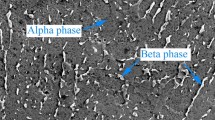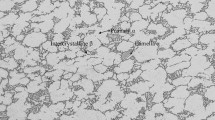Abstract
The mechanical properties of TC11 titanium alloy parts are closely related to their microstructure, and a study of the microstructure evolution during cross wedge rolling (CWR) can be beneficial for mechanical property regulation. In this paper, a WOA-BP neural network prediction model was developed and utilized to investigate the microstructure evolution of the TC11 titanium alloy hollow shaft during CWR with mandrel. Firstly, the effect of process parameters on the alpha phase grain size of TC11 titanium alloy was investigated through hot compression tests at temperatures ranging from 850 to 950 ℃, and the grain size under different conditions was obtained. Accordingly, a WOA-BP microstructure prediction model was established utilizing the whale optimization algorithm. Then, the microstructure prediction model was embedded into the software Simufact through the secondary development techniques to forecast the alpha phase grain size in the hot compression experiment and the CWR hollow shaft experiment. Finally, the CWR TC11 alloy hollow shaft experiments were conducted. The maximum error between the experiment and the predicted results is 11.07%, which means the model can accurately predict the alpha phase grain size of TC11 alloy. The results indicated that the established model can effectively predict the alpha phase grain size during CWR. Additionally, the model was used to predict the alpha phase grain size of TC11 alloy hollow shaft at different stages of CWR with mandrel.


















Similar content being viewed by others
Availability of data and material
The datasets and material generated and/or analyzed during the current study are available from the corresponding author on reasonable request.
References
Li MQ, Li H, Luo J. Precision forging of titanium alloy. 1st ed. Beijing: Science Press; 2016. (in Chinese).
Zong YY, Shan DB, Xu M, Lv Y. Flow softening and microstructural evolution of TC11 titanium alloy during hot deformation. J Mater Process Technol. 2009;209:1988–94.
Zhang LJ, Chang H, Xue XY. Thermal processing of titanium and titanium alloys. Hot Work Technol. 2013;42:82–7 (in Chinese).
Pater Z, Bulzak T, Tomczak J. Cross-wedge rolling of driving shaft from titanium alloy Ti6Al4V. Key Eng Mater. 2016;687:125–32. https://doi.org/10.4028/www.scientific.net/kem.687.125.
Li JL, Wang BY, Qin Y, Fang S, Huang X, Chen P. Investigating the effects of process parameters on the cross wedge rolling of TC6 alloy based on temperature and strain rate sensitivities. Int J Adv Manuf Technol. 2019;103:2563–77. https://doi.org/10.1007/s00170-019-03461-3.
Feng PN, Yang CP, Wang BY, Li JL, Shen JX, Yang XM. Formability and microstructure of TC4 titanium alloy hollow shafts formed by cross-wedge rolling with a mandrel. Int J Adv Manuf Technol. 2021;114:365–77. https://doi.org/10.1007/s00170-021-06635-0.
Zhao YQ, Chen YN, Zhang XM, Zeng WD, Wang L. Phase transformation and heat treatment of titanium alloys. 1st ed. Changsha: Central South University Press; 2012. (in Chinese).
Gu B, Chekhonin P, Xin SW, Liu GQ, Ma CL, Zhou L, Skrotzki W. Effect of temperature and strain rate on the deformation behavior of Ti5321 during hot-compression. J Alloys Compd. 2021;876:159938. https://doi.org/10.1016/j.jallcom.2021.159938.
Fan JK, Kou HC, Lai MJ, Tang B, Chang H, Li JS. Hot deformation mechanism and microstructure evolution of a new near β titanium alloy. Mater Sci Eng A. 2013;584:121–32. https://doi.org/10.1016/j.msea.2013.07.019.
Wu GQ, Shi CL, Sha W, Sha AX, Jiang HR. Effect of microstructure on the fatigue properties of Ti-6Al-4V titanium alloys. Mater Design. 2013;46:668–74. https://doi.org/10.1016/j.matdes.2012.10.059.
Ren JQ, Wang Q, Zhang BB, Yang D, Lu XF, Zhang XB, Zhang XD, Hu JY. Influence of microstructure on fatigue crack growth behavior of Ti–6Al–3Nb–2Zr–Mo alloy: bimodal vs. lamellar structures. Intermetallics. 2021;130:107058. https://doi.org/10.1016/j.intermet.2020.107058.
Sellars CM. Modelling microstructural development during hot rolling. Mater Sci Technol. 1990;6:1072–81. https://doi.org/10.1179/mst.1990.11.1072.
Bai Q, Lin J, Dean TA, Balint DS, Gao T, Zhang Z. Modelling of dominant softening mechanisms for Ti–6Al–4V in steady state hot forming conditions. Mater Sci Eng A. 2013;559:352–8. https://doi.org/10.1016/j.msea.2012.08.110.
Gao PF, Yang H, Fan XG, Zhu S. Unified modeling of flow softening and globularization for hot working of two-phase titanium alloy with a lamellar colony microstructure. J Alloys Compd. 2014;600:78–83. https://doi.org/10.1016/j.jallcom.2014.02.110.
Wang MJ, Sun CY, Fu MW, Liu ZL, Wang CH. Experimental investigations and constitutive modeling of the dynamic recrystallization behavior of Inconel 740 superalloy. Mater Sci Eng A. 2020;793:139939. https://doi.org/10.1016/j.msea.2020.139939.
Luo J, Li MQ. Modeling of grain size in isothermal compression of Ti–6Al–4V alloy using fuzzy neural network. Rare Met. 2011;30:555–64. https://doi.org/10.1007/s12598-011-0429-8.
Luo J, Li MQ, Yu WX. Microstructure evolution during high temperature deformation of Ti–6Al–4V alloy. Rare Metal Mat Eng. 2010;39:1323–8. https://doi.org/10.1016/s1875-5372(10)60114-2.
Quan GZ, Zhang P, Ma YY, Zhang YQ, Lu CL, Wang WY. Characterization of grain growth behaviors by BP-ANN and sellers models for nickle-base superalloy and their comparisons. Trans Nonferrous Met Soc China. 2020;30:2435–48. https://doi.org/10.1016/S1003-6326(20)65390-0.
Su Z, Sun C, Qian L, Liu C, Wang Z, Zhang L, Yan Z. A multi-angular extrusion process for fine-grain magnesium alloy plate. J Mater Res Technol. 2023;27:3670–8. https://doi.org/10.1016/j.jmrt.2023.10.050.
Zhou J, Cao XQ, Shen JX, Wang BY. A unified constitutive relationship with the internal state variables of grain evolution behavior and the application in numerical simulation of cross wedge rolling. J Mater Res Technol. 2022;21:1365–80. https://doi.org/10.1016/j.jmrt.2022.0.112.
Huo YM, Huo CL, Ren X, He T, Hosseini SRE, Wang BY, Cui YL, Jia YL, Liu KR, Du XY. Numerical prediction of microstructure evolution of high-speed railway axle formed using hot cross wedge rolling. Mater Today Commun. 2023;35:105985. https://doi.org/10.1016/j.mtcomm.2023.105985.
Luo SY, Yan K, Li J, Zou GM, Zhang P, Zeng LC. Numerical analysis on the deformation characteristics and microstructure behavior of forged IN718 aeroengine drum. Int J Adv Manuf Technol. 2023;126:3749–64. https://doi.org/10.1007/s00170-023-11392-3.
Zhang YQ, Quan GZ, Zhao J, Xiong W. Influence of variable loading path pattern on deformation and grain size in large-scale electric upsetting process of Nimonic superalloy. Int J Adv Manuf Technol. 2022;120:5933–54. https://doi.org/10.1007/s00170-022-09114-2.
Sun ZC, Yang H, Han GJ, Fan XG. A numerical model based on internal-state-variable method for the microstructure evolution during hot-working process of TA15 titanium alloy. Mater Sci Eng A. 2010;527:3464–71. https://doi.org/10.1016/j.msea.2010.02.009.
Sun ZC, Yang H, Tang Z. Microstructure evolution model of TA15 titanium alloy based on BP neural network method and application in isothermal deformation. Comp Mater Sci. 2010;50:308–18. https://doi.org/10.1016/j.commatsci.2010.08.020.
Feng PN, Wang BY, Yang CP, Han YL, Jin KN. Internal-state-variable based unified viscoplastic constitutive modeling of TC11 titanium alloy and its microstructure evolution simulation. Metall Mater Trans A. 2023;54:3662–80. https://doi.org/10.1007/s11661-023-07132-7.
Li JL, Wang BY, Huang H, Fang S, Chen P, Shen JX. Unified modelling of the flow behaviour and softening mechanism of a TC6 titanium alloy during hot deformation. J Alloys Compd. 2018;748:1031–43. https://doi.org/10.1016/j.jallcom.2018.03.120.
Zhao JW, Ding H, Zhao WJ, Huang ML, Wei DB, Jiang ZY. Modelling of the hot deformation behaviour of a titanium alloy using constitutive equations and artificial neural network. Comput Mater Sci. 2014;92:47–56. https://doi.org/10.1016/j.commatsci.2014.05.040.
Lucon PA, Donovan RP. An artificial neural network approach to multiphase continua constitutive modeling. Compos B. 2007;28:817–23. https://doi.org/10.1016/j.compositesb.2006.12.008.
Sexton RS, Dorsey RE, Johnson JD. Toward global optimization of neural network: a comparison of the genetic algorithm and backpropagation. Decis Support Syst. 1998;22:171–85. https://doi.org/10.1016/S0167-9236(97)00040-7.
Mirjalili S, Lewis A. The whale optimization algorithm. Adv Eng Softw. 2016;95:51–67. https://doi.org/10.1016/j.advengsoft.2016.01.008.
Oliva D, Elaziz MA, Hassanien AE. Parameter estimation of photovoltaic cells using an improved chaotic whale optimization algorithm. Appl Energy. 2017;200:141–54. https://doi.org/10.1016/j.apenergy.2017.05.029.
Wang JZ, Du P, Niu T, Yang WD. A novel hybrid system based on a new proposed algorithm—multi-objective whale optimization algorithm for wind speed forecasting. Appl Energy. 2017;208:344–60. https://doi.org/10.1016/j.apenergy.2017.10.031.
Aljarah I, Faris H, Mirjalili S. Optimizing connection weights in neural networks using the whale optimization algorithm. Soft Comput. 2018;22:1–15. https://doi.org/10.1007/s00500-016-2442-1.
Chen Y, Li DM, Feng S, Huang Q, Chen ZM, Shu DW. Optimization and thermal-performance deep learning on carbon/epoxy composite panels with microchannel structure for battery cooling. Appl Therm Eng. 2022;217:119162. https://doi.org/10.1016/j.applthermaleng.2022.119162.
Acikgoz O, Colak AB, Camci M, Karakoyun Y, Dalkilic AS. Machine learning approach to predict the heat transfer coefficients pertaining to a radiant cooling system coupled with mixed and forced convection. Int J Therm Sci. 2022;178:107624. https://doi.org/10.1016/j.ijthermalsci.2022.107624.
Liao HC, Gao Y, Wilson D. Development of viscosity model for aluminum alloys using BP neural network. Trans Nonferrous Met Soc China. 2021;31:2978–85. https://doi.org/10.1016/S1003-6326(21)65707-2.
Hu DC, Wang L, Wang N, Chen MH, Wang HJ. Hot tensile deformation behaviors of TA32 titanium alloy based on back-propagation neural networks and three-dimensional thermal processing maps. J Mater Res Technol. 2022;18:4786–95. https://doi.org/10.1016/j.jmrt.2022.04.144.
Wang ZH, Chen QQ, Wang ZY, Xiong J. The investigation into the failure criteria of concrete based on the BP neural network. Eng Fract Mech. 2022;275:108835. https://doi.org/10.1016/j.engfracmech.2022.108835.
Cao XQ, Wang BY, Zhou J, Shen JX. Application of unified constitutive model of 34CrNiMo6 alloy steel and microstructure simulation for flexible skew rolling hollow shafts. J Manuf Process. 2022;76:598–610. https://doi.org/10.1016/j.jmapro.2022.02.021.
Feng PN, Yang CP, Wang BY, Li JL, Liu RE. Microstructure and mechanical properties of TC4 titanium alloy hollow shaft formed by cross wedge rolling. Archiv Civ Mech Eng. 2021;21:129. https://doi.org/10.1007/s00170-021-06635-0.
Funding
This work is supported by the National Key R&D Program of China (Grant No. 2018YFB1307900) and Engineering Research Center of Part Rolling, Ministry of Education.
Author information
Authors and Affiliations
Contributions
Jian Yin did conceptualization, investigation, methodology, experimentation, data curation, writing–original draft, reviewing and editing. Cuiping Yang done supervision, conceptualization, investigation, methodology, resources, funding acquisition, reviewing and editing.
Corresponding author
Ethics declarations
Conflict of interest
The authors have no conflicts of interest/competing interests to declare that are relevant to the content of this article.
Ethical approval
The article follows the guidelines of the Committee on Publication Ethics (COPE) and involves no studies on human or animal subjects.
Consent to participate
Applicable.
Consent to publish
Applicable.
Additional information
Publisher's Note
Springer Nature remains neutral with regard to jurisdictional claims in published maps and institutional affiliations.
Rights and permissions
Springer Nature or its licensor (e.g. a society or other partner) holds exclusive rights to this article under a publishing agreement with the author(s) or other rightsholder(s); author self-archiving of the accepted manuscript version of this article is solely governed by the terms of such publishing agreement and applicable law.
About this article
Cite this article
Yin, J., Yang, C. A WOA-BP neural network microstructure evolution prediction model of TC11 titanium alloy and application in hollow shaft during cross wedge rolling with mandrel. Archiv.Civ.Mech.Eng 24, 96 (2024). https://doi.org/10.1007/s43452-024-00905-w
Received:
Revised:
Accepted:
Published:
DOI: https://doi.org/10.1007/s43452-024-00905-w




